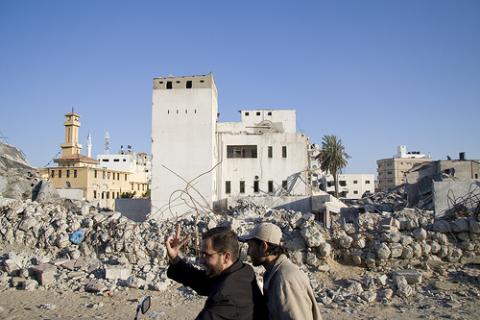Gaza's infrastructural crisis

Socialist Party MEP Paul Murphy has spent the past week in Gaza, and has been writing about his experiences for Politico. Read his account of days one and two here and here, and of the final two days of his trip below.
Back on the Egyptian side of the Rafah crossing, with our bus headed towards Cairo, our visit to Gaza has come to an end. Although far too short, it has given me a real insight into the devastating effects of the blockade as well as the potential for things to be so different. In many of the meetings we had today and yesterday, the all-consuming effect of the siege on daily life was clear, despite people’s attempts to simply get on with things. Even just driving around, the devastating lack of basic infrastructure is clear – with literally no traffic lights and the roads in very bad disrepair.
Yesterday morning, we visited Al Shifa hospital, the biggest hospital in Gaza. Through a discussion with a doctor there, it became shockingly clear how any kind of normal approach to healthcare was impossible. The hospital was constantly in crisis-management mode as a result of the blockade and the shortages that that imposed. We met with patients on dialysis machines and heard that the hospital was only five days away from running out of vital but basic parts – without them the machines would become inoperable.
Out of 450 essential drugs the hospital currently has no supplies of 150. In addition, the hospital has run out of surgical gloves. Electricity blackouts cause daily crises. To cope with this, the hospital has a bank of generators, which require constant fuel and maintenance to ensure they work properly. When we spoke with the Minister for Health, he estimated that 500 people had died as a direct result of the impact of the blockade on the health sector. Many hundreds more deaths have been caused indirectly.
Of course, the problems in the health service are not only a result of an lack of access to vital medicines and equipment. The people of Gaza are also suffering the physical and psychological effects of a brutal war. There are significantly elevated levels of depleted uranium and heavy metals in Gaza’s soil and water, which has resulted in a significant increase in the incidences of cancer.
The same picture of constant crisis-management featured in our discussions with the Coastal Municipalities Water Utility this morning. Two major water crises face the people of Gaza – a significant lack of available fresh water, together with a completely inadequate sewage system. Both of these are as a result of the blockade and the policies of the Israeli regime.
The water levels in the aquifers have been consistently declining, as more water is taken out than is replenished. The result is higher and higher levels of contamination in the water, with over 90% of the water contaminated with nitrates or other elements. One of the reasons for the declining levels is that the Israeli state has built bore-holes all along the border with Gaza to take the fresh water out, with the result that much of the water that should flow underground to the aquifers doesn’t reach it.
Plans are in place to build a major desalination plant which would go a long way to solving the water crisis. However, this project - planned to cost $500 million - has been on hold since 2005 because of lack of funding.
In terms of sewage, only 65% of the population of Gaza are connected to the sewage system. The rest use cesspits that are periodically pumped out into tankers. The inadequacies of the sewage system mean that a large amount of sewage is pumped out raw and untreated into the Mediterranean. When you pass along a stretch of the coast, perhaps around a kilometre long, the stench is almost unbearable - this is where a large amount of the raw sewage passes out.
Yesterday, we also met the fishermen who have to fish in these waters. Despite the fact that under the Oslo accord, Gazan fishermen were to be allowed to fish up to 20 miles off of Gaza, the Israeli occupation has imposed a reduction of that limit to three miles. This, understandably, has a devastating effect on the prospects for fishing, with much smaller fish being caught and a reduction in the fish stocks of those fish as a result of all of the fishermen fishing in the same area. The fishing industry, which could be an export industry for Gaza, has been almost destroyed as a result. Around 50% of the 3,500 fishermen who previously fished in Gaza have been forced out as there are simply not enough fish to be caught.
The port at Gaza, where the fishermen sail from, and which has been the target of Israeli military strikes, is dominated by a large sculpture, with a world on the top of it. This is a memorial for the nine Turkish activists who were murdered by the Israeli army on the Mavi Marmara last year, while bringing aid to Gaza. The appreciation for these activists and for all who participate in flotillas to break the blockade is very widespread. It demonstrates to me the importance of continuing to campaign to break the siege. Together with raising awareness internationally, the memorial underlines how these actions bring hope to the people of Gaza and lets them know that despite the brutal and isolating blockade, they are not struggling alone.
Image top: gloucester2gaza.
